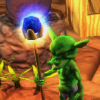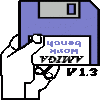So I've been pondering this for a while after watching a game review series called The Best Gamers. (www.youtube.com/user/thebestgamersusa)
They're essentially a troll show, meant to get people riled up, nothing to take seriously. However, one of the hosts made a point that is bugging me a bit,
The indie game genre (for lack of a better term) is becoming more and more out in the open with programs like Steam and Xbox Live giving people a chance to be heard under the mass of AAA developers, and that's fantastic! I love seeing all these innovative games coming up. However in terms of art design, I've noticed a trend. It seems that a large portion of indie developers are using a "retro" art style. Games like Minecraft and FEZ are good examples. This isn't directly bothersome of course, but I'm starting to get the idea that in leu of doing creative artwork for a game, developers are using retro styled graphics simply for the reason that it's easier to make. I'm not by any means saying that a game HAS to look amazing for it to be good, or ALL games have to have different or creative art styles, but I am saying that maybe the retro style is becoming less and less of a style and becoming more and more of a copout. Just a sentiment, what do you think, GD?
Retro Art Design or Laziness?
Many indies certainly are going with "retro", simply because it's easier to make. There is nothing wrong with that at all. If you're a small studio on a small budget, sometimes you have to work with what you have. Especially a one man team. If it comes down to using easy-to-make graphics and releasing, or trying for expensive and flashy graphics and never releasing, the choice is easy. Art and graphical assets are frequently the most expensive and time-consuming part of making a game. I haven't spent even a tenth of the time coding Goblinson Crusoe as I have struggling with the artwork, and there is still so much more to do that frankly the thought of it is quite daunting. Even on games with the budget to hire out, you are still going to have a lot invested in the artwork alone. When you are looking to trim the budget, you need to look first at the largest expenditures, and in games that category includes the artwork.
One of the things I find neat about indie games, is the fact that you don't have to have flashy, expensive graphics. That was always the driving force of the AAA arc: who can release the "next gen" game, with the flashiest graphics. It resulted in what are, in my opinion, extremely empty and soulless games made on multi-million dollar budgets. I remember during the 2000s, I spent a lot of money on buying the latest games, hoping that amongst all the flash and glow there would be a good game. I remember that almost without fail I was disappointed. I also remember (very recently) buying Dungeons of Dredmor, which is quite retro in appearance. Not a single big-buck AAA game I have ever bought has ever provided me with as much sheer enjoyment as DoD did. I thank the heavens that they did not opt to go with flash and fancy and expensive, and instead opted for the "easier" retro style, or the game might never have seen the light of day.
It is a tough line to walk, though. You need to balance ease of asset creation with making a good visual impression. I admit that a great many indies do, sadly, fall down there. There are plenty of indie games that I have passed over simply because I did not like the visual style, so it definitely makes a difference.
One of the things I find neat about indie games, is the fact that you don't have to have flashy, expensive graphics. That was always the driving force of the AAA arc: who can release the "next gen" game, with the flashiest graphics. It resulted in what are, in my opinion, extremely empty and soulless games made on multi-million dollar budgets. I remember during the 2000s, I spent a lot of money on buying the latest games, hoping that amongst all the flash and glow there would be a good game. I remember that almost without fail I was disappointed. I also remember (very recently) buying Dungeons of Dredmor, which is quite retro in appearance. Not a single big-buck AAA game I have ever bought has ever provided me with as much sheer enjoyment as DoD did. I thank the heavens that they did not opt to go with flash and fancy and expensive, and instead opted for the "easier" retro style, or the game might never have seen the light of day.
It is a tough line to walk, though. You need to balance ease of asset creation with making a good visual impression. I admit that a great many indies do, sadly, fall down there. There are plenty of indie games that I have passed over simply because I did not like the visual style, so it definitely makes a difference.
Bad retro graphics are easy to make.
Good retro graphics take no less time or skill to create than good 'modern' graphics, for want of a better term. All the same skills apply. Color theory, composition, interesting silhouettes, etc... Trying to get a small grid of pixels to look interesting, have a unique silhouette and read correctly is a unique skill of it's own.
Good retro graphics take no less time or skill to create than good 'modern' graphics, for want of a better term. All the same skills apply. Color theory, composition, interesting silhouettes, etc... Trying to get a small grid of pixels to look interesting, have a unique silhouette and read correctly is a unique skill of it's own.
I don't like the term easier for retro style art too. The reason is, that you can create retro style art, often sprites (pixel art), faster, though it is still hard to make it look good. The work pipeline of a AAA 3d game is really huge (concept->sculpt->low-poly->baking->texturing->rigging->animation), each step requiring lot of work and dedication. Retro/pixel art just have less steps, even if each step needs a lot of work and dedication too.
The work pipeline of a AAA 3d game is really huge (concept->sculpt->low-poly->baking->texturing->rigging->animation), each step requiring lot of work and dedication.
I'm not saying a game has to be 3D to not be retro looking. Minecraft is 3D but it maintains a retro look with its textures, while Limbo is 2D but maintains a more moderl feel with its art design.
Minecraft is 3D but it maintains a retro look with its textures, while Limbo is 2D but maintains a more moderl feel with its art design.
I would not call minecraft retro, but consistent. Using cubes to describe volume and squares to describe a texture is just consistent, and consistency is an important feature in art, but this is certainly arguable. But I call this approach as modern as limbo. Limbo is just silhouette and light/shadow, nothing new, even older than pixel art, but the composition of these elements in this way in a computer game is modern and unseen as is the use of blocky elements in minecraft.
I just want to point out, that modern/retro look is often influenced by our perception, if we don't like it, we see the negative aspects first (mehh... it looks dated) and adding furhter, unreasoned aspects too (retro => easy => lazy). Therefore is modern/retro not described by the size of the fan base
[quote name='SherrelE' timestamp='1350468632' post='4991073']
Minecraft is 3D but it maintains a retro look with its textures, while Limbo is 2D but maintains a more moderl feel with its art design.
I would not call minecraft retro, but consistent. Using cubes to describe volume and squares to describe a texture is just consistent, and consistency is an important feature in art, but this is certainly arguable. But I call this approach as modern as limbo. Limbo is just silhouette and light/shadow, nothing new, even older than pixel art, but the composition of these elements in this way in a computer game is modern and unseen as is the use of blocky elements in minecraft.
I just want to point out, that modern/retro look is often influenced by our perception, if we don't like it, we see the negative aspects first (mehh... it looks dated) and adding furhter, unreasoned aspects too (retro => easy => lazy). Therefore is modern/retro not described by the size of the fan base
[/quote]
"Consistency" could be a valid assertion, I just disagree. But to say that Limbo is old and done, I would need an example or two to believe. I'm not trying to sound pessimistic in this thread, only making a point of concern for the indie genre (again, for lack of a better term). I never said ALL retro was easy or lazy, but it seems like with this much an influx in games with the style it could be so with some cases, and I certainly wouldn't say that "modern/retro is described by the size of the fanbase," how does that factor in?
Interesting observation. I gotta say that I'm a little guilty of it myself because I've never been very talented in the art deparment, but I've been able to come up with some pretty decent, basic pixel art. I find that creating art for games is a little easier when working with the often tight contraints of retro pixel art. But it can also be a challenge as well. How do you best convey what you want in 32x16 pixels and three colors? I think someone with a talent in art would actually have a harder time conforming to retro contraints.
I think the style is popular because the indie developers now, are, for the most part, people who grew up with that style and are fondly paying tribute to it. Indie development, in some ways, is the antithesis to AAA development. AAA development is, for the most part, focused on visuals over gameplay. Indie development seems to say, "Let's strip away all these flashy visuals and go back to gameplay."
I think the style is popular because the indie developers now, are, for the most part, people who grew up with that style and are fondly paying tribute to it. Indie development, in some ways, is the antithesis to AAA development. AAA development is, for the most part, focused on visuals over gameplay. Indie development seems to say, "Let's strip away all these flashy visuals and go back to gameplay."
That's an interesting perspective, Archendrus. I think after reading your response I kind of agree.
I'd argue that it is easier to "get it right" with simpler graphics. As someone above said, consitency is important. I would even go as far as to say, consistency is THE most important factor. The more eye candy you add the harder it gets to balance everything to achieve this level of consistency.
btw, 1991:
I find limbo to be similar, of course with more colors (or grayscales ;) ), smoother animations and physics.
btw, 1991:
I find limbo to be similar, of course with more colors (or grayscales ;) ), smoother animations and physics.
This topic is closed to new replies.
Advertisement
Popular Topics
Advertisement
Recommended Tutorials
Advertisement












